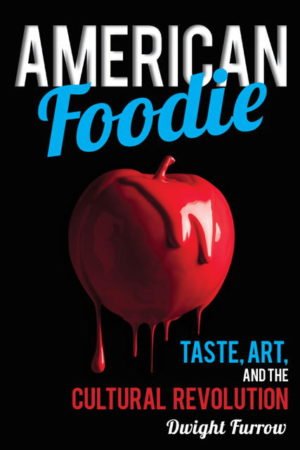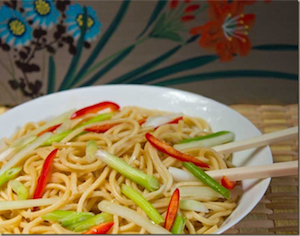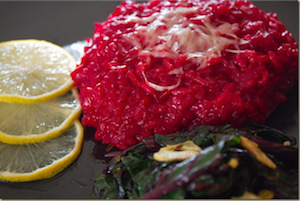Dwight Furrow Analyzes the American Foodie

We have been used to the The United States as an emerging culinary force on the global scene. Expert Dwight Furrow has his own theories about the elements of American history that have kept the nation from developing its own respected cuisine until now. He details them in AMERICAN FOODIE: Taste, Art and the Cultural Revolution.
He reports “Our Puritan heritage has always been suspicious of the pleasures of the table. And in the 20th Century when information from the science of nutrition was widely disseminated we had even more reason to ignore the pleasurable aspects of food. Add to that our hyper-mobile, work-obsessed society that values convenience over quality and the very real pressures that women had to deal with when they entered the workforce, it is no wonder it took us many years to develop a food culture.
Well-respected food expert and Sommelier Dwight Furrow examines many more copies in his comprehensive book about the contemporary fascination with food and culinary arts in his recently released book. The analysis is described as being “ both global spectacle, and as an expression of control, authenticity, and playful creation for individuals in a homogenized, and increasingly public, world.”
Furrow, a professor of Philosophy at San Diego Mesa College, incorporates his wide scope of knowledge, including the philosophy of food and wine, ethics, political philosophy, and aesthetics. He also evaluates wine for The Sommelier Company.
The book also covers:
* How food preparation and consumption is both an art form and one of life’s essential pleasures.
* How slow and purposeful approaches to food can improve our lives as opposed to fast and convenient.
* The philosophy of the foodie craze as a search for aesthetic authenticity in our increasingly pre-packaged world.
* 10 reasons to eat mindfully (that have nothing to do with losing weight)
* Why food bloggers are the heart of the food revolution.
Q and A session with the author revealed these personal answers. Dwight Furrow
Questions:
What is your favorite food to cook at home?
 Soups. They can easily be adapted to any situation, are the perfect medium for creativity in the kitchen, and hard to screw up.
Soups. They can easily be adapted to any situation, are the perfect medium for creativity in the kitchen, and hard to screw up.
What do you always have in your fridge at home?
A good cheese, preferably a little stinky.
What marked characteristic do you love in a person with whom you are sharing a meal?
A belif that the most important thing in the world is a good meal.
What marked characteristic do you find unappealing in a person with whom you are sharing a meal?
A mile-long checklist of foods they don’t like. (Exceptions for health issues of course)
Beer, wine, or cocktail?
Oh, definitely wine. Nothing goes better with food than wine.
Your favorite cookbook author?
Peter Kaminsky and Gray Kunz. To my knowledge they only wrote one cookbook, The Elements of Taste, but it was a revelation for me.
Your favorite kitchen tool?
Cast Iron Frying Pan. Versatile, indestructible, and holds up to high heat.
Favorite types of cuisine to cook?
Spanish (especially Tapas), Italian, Mexican
Beef, chicken, pork, or tofu?
Pork, nothing beats braised pork. Why is tofu on this list?
Favorite vegetable?
The ones that are really fruit: avocado and tomato
Chef you most admire?
Ferran Adrià. A genuine artist in the kitchen. Of course, his restaurant El Bulli closed. Knowing
when to quit is a virtue.
Food you like the most to eat?
Tapas-style, lots of flavor sensations in one meal. If you don’t like something you can just move
on.
Food you dislike the most?
Eggs. They are fascinating, fun to cook, and I hate that I don’t like them. But I just don’t.
What is your favorite non-food thing to do?
Read, especially philosophy. No, I’m not a masochist.
Who do you most admire in food?
Artisan winemakers, brewers, coffee-roasters, and small build-from-scratch restaurant chefs/owners. They are doing it for love.
Where is your favorite place to eat?
Home. It’s where I can be creative and where my most appreciative audience resides.
What is your favorite restaurant?
Juniper and Ivy (San Diego), Uchi (Austin), Curate (Asheville), Pok Pok (Portland)

Here is a recipes from Dwight Furrow, complete with background on why he chose to write it.
Recipe: Pan-Fried Fish Filet w/Radish and Citrus Sauce
The red radish is an afterthought. A colorful garnish or peppery accessory to a salad but seldom the star of the show. This strikes me as a great injustice. After all the radish is brightly colored, pleasingly plump, crunchy, and distinctively flavored. It’s not boring, offensive or unwelcoming. It doesn’t deserve to be ignored.
I will make it my mission in life to rectify this injustice. The problem is that radishes lose their crunch and peppery flavor when you cook them. Boredom looms. But with just enough heat they acquire a pleasing nutty/earthy flavor that pops when you pair them with caraway seeds.
So here is the launch of the Radish Redemption Project. Plenty of citrus and ginger, some soy to provide umami depth, and gently roasted radishes enhanced by the pungent notes of caraway make a fascinating sauce for buttery pan-fried fish.
Recipe is below the fold.
Serves 4
8 radishes, cleaned and trimmed
2 tablespoon olive oil (divided use)
2 small garlic cloves, minced
1/2 small onion, minced
1/2 cup fresh lime juice
1 cup fresh orange juice
2 tablespoons grated fresh ginger
2 tablespoons soy sauce
2 tablespoons honey
1 tablespoon caraway seeds, crushed
1/2 teaspoon cumin
1/2 cup flour seasoned with salt and pepper
4 fish filets, mildly flavor such as tilapia or halibut
2 tablespoons butter
cilantro for garnish
Directions:
- Preheat oven to 400 degrees.
2. Slice radishes in half, pole to pole, then place the cut side down and cut each half into thirds. (Each radish is cut into 6 equal portions)
3. Toss sliced radishes with 1 tablespoon olive oil and roast in the oven for 6-8 minutes. Reserve. (Radishes should still have some crunch but lose their raw flavor. Be careful not to overcook)
4. Warm olive oil over medium heat. Saute onions and garlic until soft.
5. Add ginger and cook briefly then add citrus juices soy sauce, honey, caraway seeds, and cumin and stir. When sauce begins to simmer reduce heat to low then cover so the sauce does not reduce too much.
6. Pat fish dry and put seasoned flour on a dish or pan
7. Heat frying pan to medium high and melt butter (be careful not to burn the butter)
8. Dredge fish in flour and fry in frying pan until fish is lightly browned and cooked through. (If your frying pan is too small for 4 filets, cook them 2 at a time and keep warm in the oven.)
9. While fish is cooking, adjust consistency of the sauce if necessary, add radishes to the sauce and increase the heat briefly so they will warm.
10. To serve, distribute sauce on plates with radishes on the border, top with fish filet and garnish with cilantro.
The book includes:
* How food preparation and consumption is both an art form and one of life’s essential pleasures.
* How slow and purposeful approaches to food can improve our lives as opposed to fast and convenient.
* Elements of American history that have kept the nation from developing its own respected cuisine – until now.
* The philosophy of the foodie craze as a search for aesthetic authenticity in our increasingly pre-packaged world.
* 10 reasons to eat mindfully (that have nothing to do with losing weight)
* Why food bloggers are the heart of the food revolution.
Furrow is a professor of Philosophy at San Diego Mesa College, whose writes on the philosophy of food and wine, ethics, political philosophy, and aesthetics. He also evaluates wine for The Sommelier Company.
Elements of American history that have kept the nation from developing its own respected cuisine – until now.
Our Puritan heritage has always been suspicious of the pleasures of the table. And in the 20th Century when information from the science of nutrition was widely disseminated we had even more reason to ignore the pleasurable aspects of food. Add to that our hyper-mobile, work-obsessed society that values convenience over quality and the very real pressures that women had to deal with when they entered the workforce, it is no wonder it took us many years to develop a food culture.
Dwight Furrow
Questions:
What is your favorite food to cook at home?
Soups. They can easily be adapted to any situation, are the perfect medium for creativity in the kitchen, and hard to screw up.
What do you always have in your fridge at home?
A good cheese, preferably a little stinky.
What marked characteristic do you love in a person with whom you are sharing a meal?
A belif that the most important thing in the world is a good meal.
What marked characteristic do you find unappealing in a person with whom you are sharing a meal?
A mile-long checklist of foods they don’t like. (Exceptions for health issues of course)
Beer, wine, or cocktail?
Oh, definitely wine. Nothing goes better with food than wine.
Your favorite cookbook author?
Peter Kaminsky and Gray Kunz. To my knowledge they only wrote one cookbook, The Elements of Taste, but it was a revelation for me.
Your favorite kitchen tool?
Cast Iron Frying Pan. Versatile, indestructible, and holds up to high heat.
Favorite types of cuisine to cook?
Spanish (especially Tapas), Italian, Mexican
Beef, chicken, pork, or tofu?
Pork, nothing beats braised pork. Why is tofu on this list?
Favorite vegetable?
The ones that are really fruit: avocado and tomato
Chef you most admire?
Ferran Adrià. A genuine artist in the kitchen. Of course, his restaurant El Bulli closed. Knowing
when to quit is a virtue.
Food you like the most to eat?
Tapas-style, lots of flavor sensations in one meal. If you don’t like something you can just move
on.
Food you dislike the most?
Eggs. They are fascinating, fun to cook, and I hate that I don’t like them. But I just don’t.
What is your favorite non-food thing to do?
Read, especially philosophy. No, I’m not a masochist.
Who do you most admire in food?
Artisan winemakers, brewers, coffee-roasters, and small build-from-scratch restaurant chefs/owners. They are doing it for love.
Where is your favorite place to eat?
Home. It’s where I can be creative and where my most appreciative audience resides.
What is your favorite restaurant?
Juniper and Ivy (San Diego), Uchi (Austin), Curate (Asheville), Pok Pok (Portland)
Do you have any tattoos? And if so, how many are of food?
No
ecipe: Pan-Fried Fish Filet w/Radish and Citrus Sauce
The red radish is an afterthought. A colorful garnish or peppery accessory to a salad but seldom the star of the show. This strikes me as a great injustice. After all the radish is brightly colored, pleasingly plump, crunchy, and distinctively flavored. It’s not boring, offensive or unwelcoming. It doesn’t deserve to be ignored.
I will make it my mission in life to rectify this injustice. The problem is that radishes lose their crunch and peppery flavor when you cook them. Boredom looms. But with just enough heat they acquire a pleasing nutty/earthy flavor that pops when you pair them with caraway seeds.
So here is the launch of the Radish Redemption Project. Plenty of citrus and ginger, some soy to provide umami depth, and gently roasted radishes enhanced by the pungent notes of caraway make a fascinating sauce for buttery pan-fried fish.
Recipe is below the fold.
Serves 4
8 radishes, cleaned and trimmed
2 tablespoon olive oil (divided use)
2 small garlic cloves, minced
1/2 small onion, minced
1/2 cup fresh lime juice
1 cup fresh orange juice
2 tablespoons grated fresh ginger

 Gerry Furth-Sides
Gerry Furth-Sides  Barbara Hansen
Barbara Hansen  Chef-owner Alain Cohen
Chef-owner Alain Cohen  Roberta Deen
Roberta Deen  Jose Martinez
Jose Martinez  Nivedita Basu
Nivedita Basu